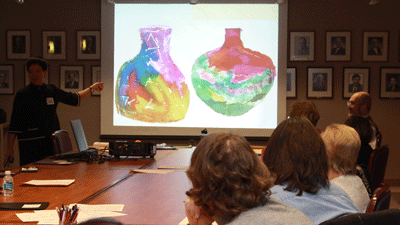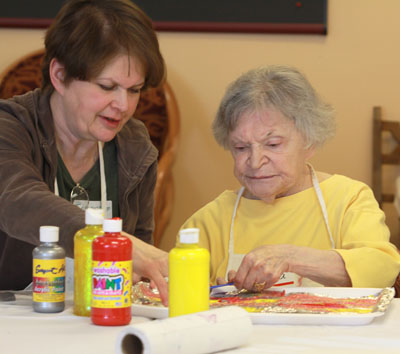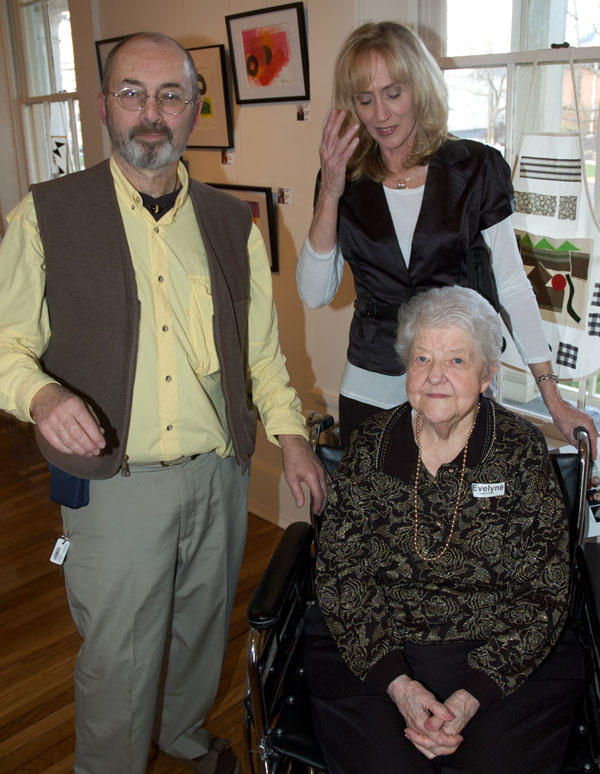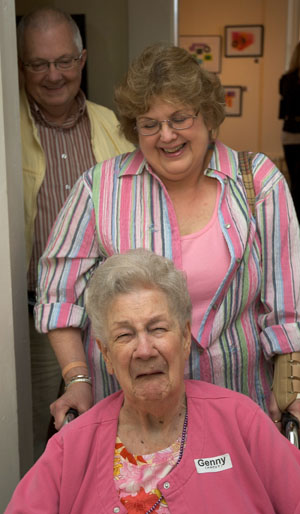Research
Evaluation Forms - are now available!
Articles about OMA
OMA: Conceptual Foundations and Methodology (Lokon, 2008).
This thesis describes the why and how of OMA. In includes a review of the literature and evaluation forms used to assess the effectiveness of the program.
Read more at: http://tinyurl.com/mw39sy
OMA at Cedar Village (Lokon, 2009).
This report documents evaluation results of OMA's first semester implementation at Cedar Village. Both quantitative and qualitative evaluations are reported.
Read more at: ReportS2009
Articles on the Arts, Aging, and Dementia
Arts in dementia care: 'This is not the end ... it's the end of this chapter'. (Basting, A. D. ,2006).
This article introduces the positive role that arts can have on older adults with dementia. Basting explains how various art forms can help the individual to communicate and thus increase their quality of life. The article also touches on several of the art programs available for those with dementia. 
Read more at: Basting_2006
Creativity and aging: Ramifications for research, practice, and policy.(Cohen, D. G., 1998).
This article focuses on how the possibility for creative growth for older adults is often ignored. It uses various examples to show that creativity is one aspect of a person’s life which is not negatively affected by aging.
Read more at: http://tinyurl.com/lacudy
Research on creativity and aging: The positive impact of the arts on health and illness. (Cohen, D. G., 2006).
This article presents the positive effects of creativity on one's health. A study focusing on aging and creativity and its results are also presented.
Read more at: Cohen_2006
Impact of professionally conducted cultural programs on the physical health, mental health, and social functioning of older adults. (Cohen, G. D., Perlstein, S., Chapline, J., Kelly, J., Firth, K. M., 2006).
This study compared the impact of creative expression programs such as painting, writing, poetry, jewelry making etc. with the impact of other non-creative programs, on the health and well-being of older adults. They found that those participating in the creative expression programs showed better overall health and well-being scores.
Read more at: Cohen_2006_2
Impact of TimeSlips, a Creative Expression Intervention Program, on Nursing Home Residents With Dementia and their Caregivers (Fritsch,T., Kwak, J., Grant, S., Lang, J., Montgomery, R. R., Basting, A. D. 2009).
This study compared ten nursing homes that have adopted TimeSlips with ten nursing homes that have not. The results showed positive effects of TimeSlips on the quality and quantitity of staff-resident interactions and higher levels of resident engagement in the TimeSlips nursing homes.
Read more at: Fritsch_etal_2009
Observed well-being among individuals with dementia: Memories in the Making, an art program, versus other structured activity. (Kinney, J. M., Rentz, C. A., 2005).
This study looked at the benefits of the Memories in the Making program compared to other non-creative structured activities. The results showed that overall the people with dementia exhibited more pleasure, sustained attention, self-esteem and normalcy throughout the Memories in the Making activity.
Read more at: Kinney_&_Rentz_2005
A multi-centre randomized control group trial on the use of art therapy for older people with dementia (Rusted et al., 2006).
This study evaluates the immediate and long-term effects of art therapy for older people with dementia (PWD) as compared with non-emotional activities. Forty-five PWD participated in 40 weekly sessions.
Read more at: Rusted_2006
Quality of Life of People With Dementia
Dementia Care Mapping: A Review of the Research Literature. (Brooker, 2005). This review looks at Dementia Care Mapping and its efficacy based on published literature. Problems with the tool and options for future improvement and research are discussed.
Read more at: Brooker_2005
Characteristics associated with lower activity involvement in long-term care residents with dementia. (Dobbs, D., Munn, J., Zimmerman, S., Boustani, M., Williams, C. S., Sloane, P. D., Reed, P. S., 2005).
This study investigated the circumstances which affected the degree of activity involvement of residents with dementia in long-term care settings. It reports the effect of staff encouragement as well as family involvement in the residents' care.
Read more at: Dobbs_2005
A Comparison of Three Methods of Measuring Dementia-Specific Quality of Life: Perspectives of Residents, Staff, and Observers. (Edelman, P., Fulton, B., Kuhn, D., Chang, C., 2005).
This study looked at three different methods of measuring the quality of life for those with dementia.
Read more at: Edelman_2005
Caring for people with Alzheimer's disease and related dementias: Strengths-based approaches. (Ronch, J. L., 2003). 
This chapter is about strength-based psychology, which is at the core of the person-centered approach to dementia care.
Read more at: Ronch_2003
Evaluating the Quality of Life of Long-Term Care Residents With Dementia. (Sloane, P., Zimmerman, S., Williams, C., Reed, P., Gill, K., Preisser, J., 2005).
This study looked at various measures of quality of life. The article showed how different measures could be compared. It argued that understanding the efficiency of these measures and how they relate are essential to improve the evaluation outcomes.
Read more at: Sloane_2005
Leisure activities and the risk of dementia in the elderly. (Verghese, J., Lipton, R. B., Katz, M. J., et al., 2003).
This study looked at the effect of several different leisure activities on the development of dementia in a group of people. The results showed that by participating in these activities it decreased the likelihood of becoming demented. All of the data for each of the activities are reported separately to give insight into each activity.
Read more at: http://tinyurl.com/m4oodw

